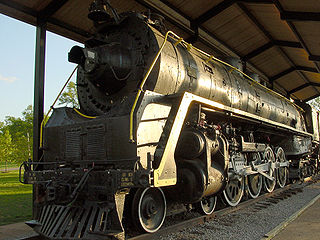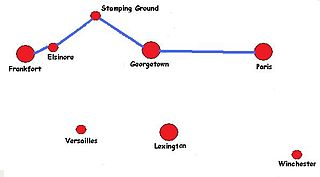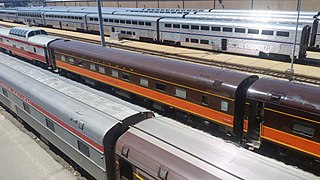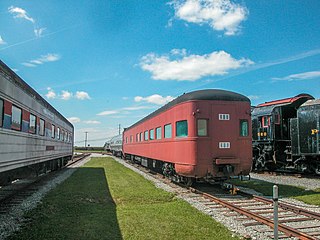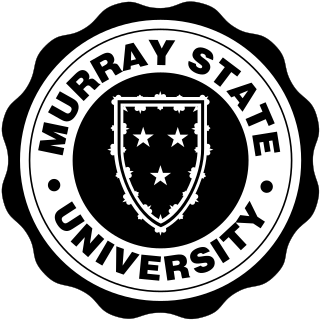| Mt. Broderick 10-section buffet-lounge | |
|---|---|
| Manufacturer | Pullman Company |
| Order no. | Lot 4998 |
| Constructed | 1926 |
| Diagram | Plan 3521A, later 3521L |
| Capacity | 20 in 10 sections |
| Specifications | |
| Weight | 93 short tons (84 t) |
| Bogies | Type 2410A |
| Track gauge | 4 ft 8 1⁄2 in (1,435 mm) |
MT. BRODERICK Pullman Lounge-Obs-Sleeping Car | |
| Location | 136 S. Main St., New Haven, Kentucky |
|---|---|
| Coordinates | 37°39′22″N85°35′34″W / 37.65611°N 85.59278°W Coordinates: 37°39′22″N85°35′34″W / 37.65611°N 85.59278°W |
| Built | 1926 |
| Architect | Pullman Company, Chicago, IL |
| Architectural style | Railroad Car |
| NRHP reference # | 97001345 [1] |
| Added to NRHP | November 18, 1997 |
The Mt. Broderick Pullman Car is a historic railcar on the National Register of Historic Places, currently at the Kentucky Railway Museum at New Haven, Kentucky, in southernmost Nelson County, Kentucky. It has been described as a "four-star hotel" on rails. [2]

The National Register of Historic Places (NRHP) is the United States federal government's official list of districts, sites, buildings, structures, and objects deemed worthy of preservation for their historical significance. A property listed in the National Register, or located within a National Register Historic District, may qualify for tax incentives derived from the total value of expenses incurred preserving the property.
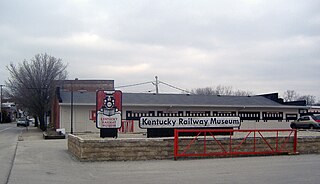
The Kentucky Railway Museum, now located in New Haven, Kentucky, United States, is a non-profit railroad museum dedicated to educating the public regarding the history and heritage of Kentucky's railroads and the people who built them. Originally created in 1954 in Louisville, Kentucky, the museum is at its third location, in extreme southern Nelson County. It is one of the oldest railroad stations in the United States.

New Haven is a home rule-class city in Nelson County, Kentucky, United States. The population was 849 at 2000 census.
Mt. Broderick was built in two months in late 1926 at the Pullman factory in Chicago, Illinois. It was one of thirty cars built on Lot 4998 to Plan 3521A. [3] It had ten sections (numbered 1 to 10) and a 12-seat lounge area (numbered 11 to 22). [4] In its normal overnight-mode, it could sleep 20, although in day-mode, it could seat a maximum of fifty-two passengers. It weighed 93 tons, due in part to its poured concrete floor; a feature unique to the Mt. Broderick. Passengers enjoyed the solarium lounge at its rear, as well as its buffet area. Polished brass fixtures were in the restroom area. Modifications to the car in 1935 included redoing the solarium, and replacing its crude blown air onto ice method of cooling to a then-modern air conditioning system. [5] It ran the "Southland" Route of the Louisville and Nashville Railroad in the 1940s and 1950s; Atlanta, Chicago, Cincinnati, Fort Wayne, and St. Louis were regular stops of the route. [6]

The Pullman Car Company, founded by George Pullman, manufactured railroad cars in the mid-to-late 19th century through the first half of the 20th century, during the boom of railroads in the United States. Through rapid late nineteenth century development of mass production, and takeover of rivals, the company developed a virtual monopoly on production and ownership of sleeper cars. At its peak in the early 20th century, its cars accommodated 26 million people a year, and it in effect operated "the largest hotel in the world". Its production workers initially lived in a planned worker community named Pullman, Chicago. Pullman developed the sleeping car, which carried his name into the 1980s. Pullman did not just manufacture the cars, it also operated them on most of the railroads in the United States, paying railroad companies to couple the cars to trains. The labor union associated with the company, the Brotherhood of Sleeping Car Porters, founded and organized by A. Philip Randolph, was one of the most powerful African-American political entities of the 20th century. The company also built thousands of streetcars and trolley buses for use in cities. Post World War II changes in automobile and airplane transport led to a steep decline in the company's fortunes. It folded in 1968.
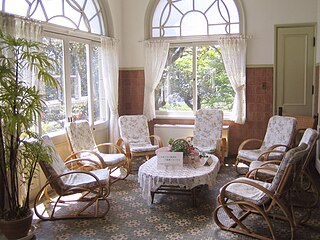
A sunroom, also frequently and traditionally denominated a solarium, is a room that is built, either attached to, or integrated into, the primary building, such as a residence or office, that permits abundant daylight and views of the landscape while sheltering from adverse weather. Sunroom and solarium have the same denotation: solarium is Latin for "place of sun[light]". Solaria of various forms have been erected throughout European history. Presently, the sunroom or solarium is popular in Europe, Canada, the United States, Australia, and New Zealand. Sunrooms may feature passive solar building design to heat and illuminate them.

A buffet is a system of serving meals in which food is placed in a public area where the diners serve themselves. A form of service à la française, buffets are offered at various places including hotels, restaurants, and many social events. Buffet restaurants normally offer all-you-can-eat food for a set price, but some measure prices by weight or by number of dishes. Buffets usually have some hot dishes, so the term cold buffet has been developed to describe formats lacking hot food. Hot or cold buffets usually involve dishware and utensils, but a finger buffet is an array of foods that are designed to be small and easily consumed only by hand, such as cupcakes, slices of pizza, foods on cocktail sticks, etc.
The Kentucky Railway Museum purchased the Mt. Broderick from the Pullman Company in 1958. It replaced the paint and carpet of the car with paint and carpet from the Pullman company, to keep it looking as it did during its active days. The car was also restored in late 1997. [7]
The Mt. Broderick Pullman Car is one of four artifacts at the Kentucky Railway Museum on the National Register of Historic Places. The others are the Louisville and Nashville Steam Locomotive No. 152, the Louisville and Nashville Combine Car Number 665, and the Frankfort and Cincinnati Model 55 Rail Car.

The Louisville and Nashville Combine Car Number 665, also known as the "Jim Crow Car", is a historic railcar on the National Register of Historic Places, currently at the Kentucky Railway Museum at New Haven, Kentucky, in southernmost Nelson County, Kentucky.

The Frankfort and Cincinnati Model 55 Rail Car, also known as "The Cardinal" is a historic railcar on the National Register of Historic Places, currently at the Kentucky Railway Museum at New Haven, Kentucky, in southernmost Nelson County, Kentucky.




